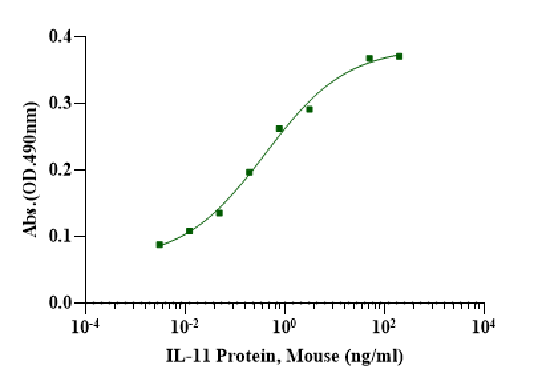Measured in a cell proliferation assay using TF-1 human erythroleukemic cells, the EC50 for this effect is less than 1ng/ml.
Product Details
Product Details
Product Specification
| Species | Mouse |
| Synonyms | Interleukin-11. IL-11 |
| Accession | P47873 |
| Amino Acid Sequence | Pro22-Leu199 |
| Expression System | E.coli |
| Molecular Weight | 19 kDa (Reducing) |
| Purity | >95% by SDS-PAGE & HPLC. |
| Endotoxin | <0.1EU/μg |
| Conjugation | Unconjugated |
| Tag | No Tag |
| Physical Appearance | Lyophilized Powder |
| Storage Buffer | 20mM Tris, 250mM NaCl, pH9.0 |
| Reconstitution | Reconstitute at 0.1-1 mg/ml according to the size in ultrapure water after rapid centrifugation. |
| Stability & Storage |
· 12 months from date of receipt, lyophilized powder stored at -20 to -80℃. · 3 months, -20 to -80℃ under sterile conditions after reconstitution. · 1 week, 2 to 8℃ under sterile conditions after reconstitution. · Please avoid repeated freeze-thaw cycles. |
| Reference | Exp Mol Med. 2020 Dec;52(12):1871-1878. |
Background
IL11 is a pro-inflammatory and pro-fibrotic member of the IL-6 family of cytokines that share commonality in the glycoprotein 130 (gp130) signaling receptor subunit, in combination with their cytokine-specific cognate receptors. This family of cytokines and their cognate receptors have been regarded as important contributors to cancer biology, and may serve as potential biomarkers in disease progression. IL-11 was considered (and is still thought) to be important for platelet function and to be cytoprotective, anti-inflammatory, and antifibrotic in organs, including the lung. However, advances made in the past few years using species-matched IL-11 in disease models in vitro and in vivo have begun to suggest an alternative role for IL-11. IL-11 signaling is now known to be centrally important for lung pathology and promotes a broad range of maladaptive effects, including lung epithelial cell dysfunction, stromal-driven inflammation, and myofibroblast activation.
Picture
Picture
Bioactivity

SDS-PAGE
2μg (R: reducing condition, N: non-reducing condition).
SEC-HPLC
>95% as determined by SEC-HPLC.


